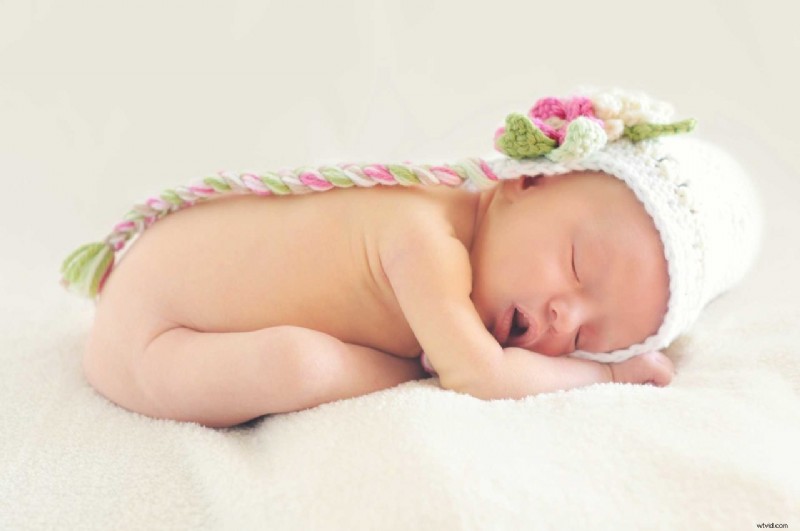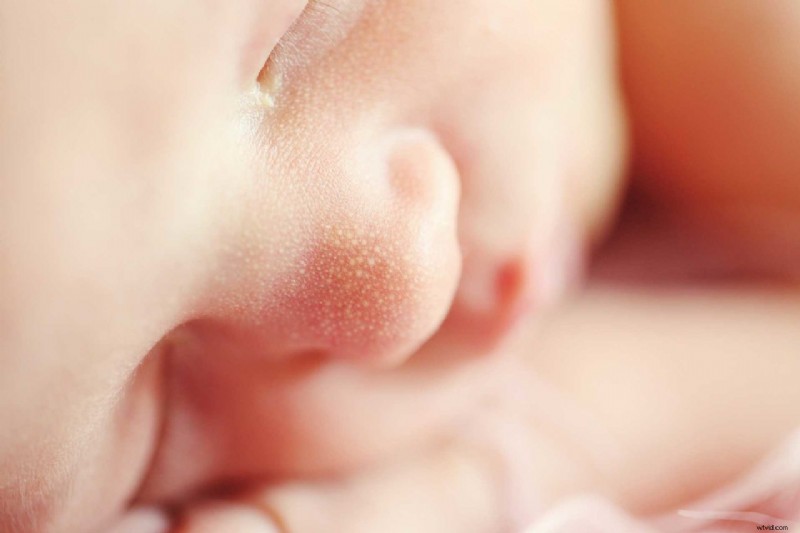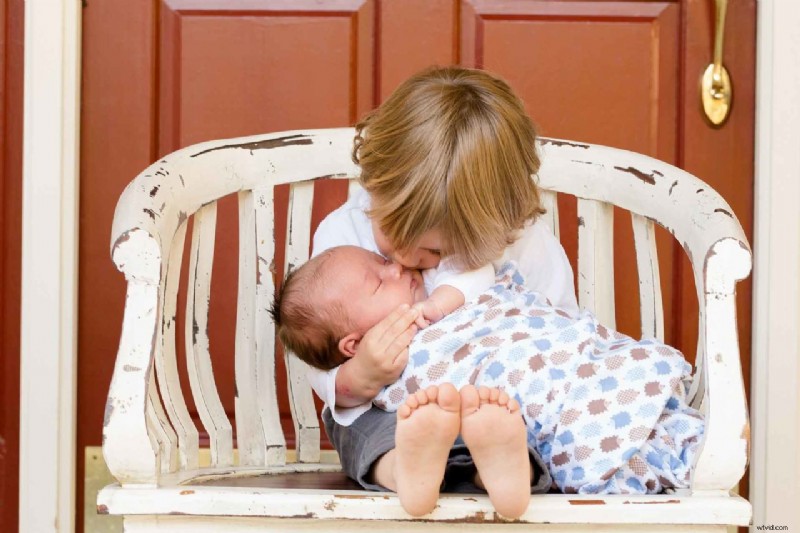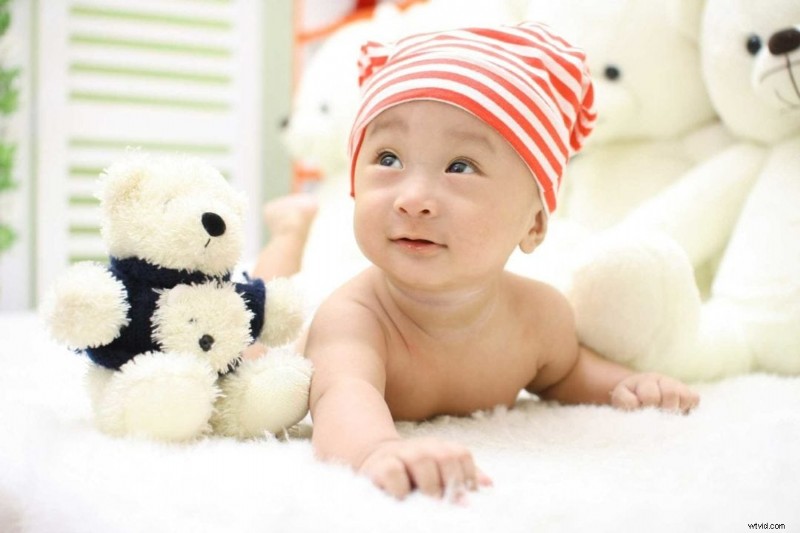I bambini sono probabilmente i soggetti più fotografati al mondo, eppure è notoriamente difficile lavorarci. È praticamente impossibile comunicare la direzione a un bambino, lasciando sia il fotografo che il soggetto pronti all'impazienza e all'irritabilità. Certo, la fotografia di bambini può essere molto divertente, ma siamo stati tutti in quel punto delicato in bilico per la frustrazione. Non sarebbe bello rinunciare a un po' di quello stress? Si spera che questi 49 favolosi consigli e trucchi per la fotografia di bambini eliminino un po' della tua tensione.
Suggerimenti per la fotografia di bambini per pianificare uno scatto
1. Scegli il momento migliore
Siamo tutti creature abitudinarie, compresi i bambini. Forse con l'eccezione dei neonati, quasi tutti i bambini saranno abituati a fare certe cose in certi momenti della giornata. Consulta i genitori per determinare quando il bambino sarà probabilmente più calmo e prova a sparare durante questo periodo. Anche se questo non è del tutto infallibile, probabilmente aumenterà le tue possibilità di un bambino collaborativo.
2. Conosci la tua illuminazione
Dopo aver determinato l'ora del giorno in cui scattare, scegli una posizione ottimale per fotografare. In questo caso, l'oggetto punta a fonti di luce naturale. Cerca di trovare un posto vicino a una finestra o a una porta a vetri, ma tieni presente che la luce, proprio come i bambini, può cambiare.
3. Spogliarsi in anticipo
Molti servizi fotografici per neonati vengono eseguiti senza che il bambino indossi alcun vestito. La pelle del bambino è sensibile e i suoi vestiti tendono a lasciare segni, quindi è una pratica saggia rimuovere qualsiasi indumento prima di sparare per consentire alla pelle del bambino di adattarsi.
4. Scelta del colore
Se stai fotografando il bambino con i suoi vestiti, considera come il suo vestito interagisce con lo sfondo su cui stai scattando. Sì, anche i vestiti per bambini possono stonare!
5. Prepara la tua attrezzatura prima delle riprese
Il tempo è essenziale quando scatti foto ai bambini. Una stima generosa sarebbe di 10 minuti di riprese. Fai in modo che le tue lenti siano pulite e la tua attrezzatura a portata di mano prima che l'orologio inizi a ticchettare per garantire la massima quantità di tempo con il tuo soggetto.
Se sei fortunato, avrai forse 10 minuti di tempo per le riprese con un bambino irrequieto. Non sprecarlo pulendo gli obiettivi, controllando nella borsa l'obiettivo di cui hai bisogno, ecc. Tieni tutto ciò di cui hai bisogno, pulito e a portata di mano prima di iniziare a scattare.
VEDI ALTRO: 22 consigli per la fotografia di neonati che ogni genitore dovrebbe seguire

6. Concedi tempo sufficiente
Solo perché il tuo tempo di ripresa effettivo potrebbe essere breve, non significa che non dovresti pianificare l'imprevisto. Prendi in considerazione potenziali capricci, cambi di pannolino, alimentazione, ecc. Concediti un ampio spazio di tempo, per ogni evenienza.
7. Impiega risorse
Ci sono un sacco di siti web là fuori (Pinterest è un pezzo grosso) che sono pieni zeppi di suggerimenti per la messa in scena e la posa per fotografare i bambini. Utilizza queste risorse e consultale in anticipo.
8. Fai una lista
Come abbiamo affermato in quasi tutti i punti finora, i bambini sono capricciosi. Non sai mai quanto durerà il loro stato d'animo fotogenico, quindi assicurati di avere un elenco degli scatti che vuoi fare. In questo modo, puoi spuntarli mentre procedi invece di perdere tempo prezioso cercando di ricordarli.
9. Usa un treppiede
I treppiedi sono decisamente utili quando si fotografano i bambini perché lasciano le mani libere per posare o distrarre il bambino per suscitare le espressioni desiderate (per i bambini più grandi). Ovviamente, come per il resto della preparazione per la fotografia del bambino, ti consigliamo di installare il treppiede in anticipo.
10. App per la fotografia di bambini
Sì, c'è un'app per questo. Non sottovalutare il tuo smartphone quando si tratta di fotografare i più piccoli. Esistono diverse app gratuite sia per iOS che per Android che riproducono suoni divertenti per attirare l'attenzione del bambino sul tuo obiettivo.
11. Proponilo
Siti web come Etsy presentano mercati pieni di venditori che cercano di scaricare tutti i tipi di oggetti di scena adatti per la fotografia di bambini. Cappelli, fiocchi e bozzoli sono alcune delle scelte più popolari, ma non aver paura di essere creativo nelle tue selezioni. Inoltre, puoi sempre rivendere tutti gli articoli che acquisti una volta che hai finito con loro.
12. Tieni d'occhio i cestini
Parlando di oggetti di scena, non dimenticare i cestini. Ti permettono di posare un bambino in un modo pratico e senza tempo (pensa ai neonati o ai bambini piccoli). Tieni gli occhi aperti per quelli poco profondi che mostreranno bene il bambino. I negozi per la casa come Homebase o Ikea in genere hanno delle buone scoperte. Se non riesci a trovare un cesto poco profondo, imbottisci semplicemente il fondo di uno normale con asciugamani, coperte o cuscini.
13. Spazio vuoto
Anche qui abbiamo a che fare con la preparazione. Non vuoi che nulla ti impedisca di catturare il bambino mentre fa qualcosa di eccezionale. Questo è esattamente il motivo per cui dovresti formattare la scheda di memoria prima di ogni scatto. Puoi stare certo che il momento migliore arriverà l'unica volta che non lo farai.
VEDI ALTRO: 11 toddler photography tips for gorgeous portraits of your child

Baby photography tips for during the shoot
14. Always in raw format
It’s typically always good practice to shoot in raw format, but particularly with babies. If the shots you manage to grab are a bit off you can easily fix them in Photoshop.
15. Experiment with focus points
Traditional “rules” tell us to focus on the eyes, but it certainly doesn’t hurt to break those rules every once in awhile. Try different focal points, such as the baby’s hand or feet while blurring the rest of them, and then go back to the face. Each photo will have a totally different look and will typically work well together as a pair.
16. Keep calm
This one may seem a bit obvious, but it’s important to keep calm during photo shoots with babies. Sure, they can’t communicate with us a traditional way, but they are undoubtedly receptive to our moods and feelings. It’s quite likely that if you’re stressed about the shoot, the baby will be too.
17. Keep quiet
This is where your quiet or silent shooting mode will come in handy. Babies, as we all know, can be easily distracted and even scared by loud beeps and shutter releases. As an alternative, you could play some soothing music to mask your shutter noise.
18. Pick the best aperture
Wide apertures are well-suited for most portraits, including baby shots. Try an f/1.4 or f/1.8, but keep in mind that slight movements of the baby can throw off the focus due to the very shallow depth of field. It might be the case that something a bit narrower such as f/2.8 would better. It’s wide enough to blur the background while at the same time giving you a bit of wiggle room when it comes to slight movements.
19. Keep on shooting
Don’t focus all of your concentration on the formal shoot. Breaks in the shoot due to routine baby care can provide convenient opportunities for impromptu lifestyle shots that show the family interacting with the baby. Try to steer these interactions toward natural light to grab a striking shot.
20. Make a montage
If you follow the advice in the previous step, you’ll end up not just with beautiful posed shots, but all the moments in between. Photos of feedings, changings, and the baby’s things add realism to the posed shots, creating a well-rounded set of images. Turning these photos into a collage or montage will provide a nicely thorough expression of the day’s shoot.
21. Shoot in aperture priority
Since you’ll most likely be using wide apertures for baby portraits, shoot in aperture priority mode to give yourself the freedom to work quickly without having to concern yourself with setting the shutter speed. Select your aperture according to your desired depth of field.
22. Shoot in burst mode
Burst mode is especially convenient if you have an infant on the move. Shooting in this mode will allow you to capture all of the baby’s movements. Silent burst modes are even more optimal as the rapid shutter speed sound can be a little alarming to babies.
23. Bounce the flash
The flash can be very harsh for babies both big and small, but if you find that you absolutely need to use it, use an external flashgun indirectly by bouncing it off the ceiling or an opposite wall. The results will likely be more natural and less interfering.
24. Warm your hands!
It can be easy to forget how sensitive babies are. Be sure to give your hands a good rub to warm them up before touching any bare baby skin. The last thing you want to do is disturb the baby with cold fingers and have to start from scratch.
25. Same pose, different backgrounds
Using the same pose/angle works well for newborns, but it can work for older babies, too. Switching out backgrounds helps create that desired montage look we discussed in tip 21. If you don’t have a background holder, simply attach large pieces of card or material to a wall, or look for a volunteer to hold them up for you.
26. Pick the best lens
As we discussed before, wide apertures and shallow depths of field are perfect for babies. It supplies that wistful, innocent look that’s so well-suited for youth. A good starting lens is a 50mm f/1.8, which can be purchased fairly cheaply. Really anything that opens up wide, such as f/1.4 or f/1.8 will work well.
27. Try out a macro lens
Macro lenses can be surprisingly versatile, allowing you to not only pick out small details on the baby, but they also offer a classic portrait length (such as 60mm or 100mm) and open wide (typically f/2.8).
VEDI ALTRO: Family portrait ideas for people who don’t shoot portraits

28. Don’t lose focus
You probably won’t have much luck convincing a baby to sit perfectly still for a portrait. A fidgety subject means you’ll have to refocus between shots, or switch to continuous AF to keep up with the movements.
29. Bring a change of clothes
Babies can be quite messy, so if you’re shooting somewhere other than its home, make sure to have a spare set of clothes on hand. This is not only practical but also creates some variety in the shots.
30. Reflect the light
Whether or not you use a reflector can have a serious impact on your portrait shots. This is especially true for baby shots because you’re going to want to avoid using artificial light. Some reflectors are composed of several different panels, each creating its own type of light. A white reflector creates neutral, even light, a gold reflector will cast warmer tones, and a silver reflector creates harsh, cold light.
31. DIY Reflector
Reflectors are actually quite easy to make yourself. By covering one side of a large piece of white card with foil, you can create a double sided reflector that’s just as efficient as store-bought one.
32. Choose the best ISO
Shooting a moving baby in natural light means you’re going to need a mid-high ISO to achieve a fast shutter speed. ISO 400 is a good start, but you may need to push it to ISO 800 or 1600 to achieve the focus you want.
Don’t be afraid of a little noise, it’s better than an image that’s out of focus. Set to the top limit of your camera’s automatic ISO (if it has this feature) to save even more time while shooting.
33. Clean up operation
Be prepared for messes with baby wipes. It’s not as easy to remove spots and specks after the shoot in Photoshop as it is to clean the baby in person during the shoot.
34. Focal lengths
Don’t go for that giant lens when you want a close up of the baby. These can be frightening and overwhelming for babies. Best avoid wide angle lenses, too, as these can tend to result in a distorted look.
Instead, make use of longer focal lengths (50mm or above) when you want a close up, and if you’re using a zoom lens, be sure to use the telephoto end.
35. Always be ready
Babies are impulsive and unstructured, and it’s the moments that result from this behavior that you’ll want to capture. Try to increase your chances of doing so by keeping your main camera near the area where you spend the majority of the time with the baby.
If you have another camera on hand, stash it in a part of the house that’s further away from your main camera. This way, you won’t be sprinting across the house when the baby does something amusing.
36. Fast shutter speeds
Newborns typically don’t move all that much, so a slower shutter speed will do. Infants, on the other hand, can be quite squirmy so you’ll want to use a shutter speed of 1/100 or quicker.
37. Focus on the eyes
Babies tend to communicate a lot of emotion through their eyes, so not unlike your other portraits you’ll want to set the focus point to the baby’s eye. If the baby moves you’ll have to refocus.
38. Rosy glow
Bath time typically brings a bright rosy glow to the baby’s face, which is lovely to photograph. A quick rub with the towel will dishevel hair for even more cuteness, and the towel can be used to frame the baby’s face for the shot.
39. Ring the changes
A compilation of images of a baby throughout time can be a nice thing to share with family and friends. Chose one spot in which you’ll photograph the baby every week or so for a year. The changes are sure to be evident.

40. Get down low
Just like you would in other situations, try unusual angles to capture some interesting shots. For instance, put the camera on the floor and point it up at the baby – face or feet, it doesn’t matter! Articulating screens can be particularly useful for framing shots in this case. Just play around with different angles and see what happens!
41. Keep it simple
Toys and baby supplies usually abound wherever the baby is. You don’t want to distract from the baby in the shot, so try to keep your background free of distractions. A stray rattle or teddy bear can peek out from behind the baby and steal the show.
42. Know when to stop
Don’t try to push it when the baby gets irritable or stressed. All you will accomplish is upsetting the baby further, and you really can’t get any good shots anyway when the baby is cranky. Simply take a break and have mum or dad attend to the baby’s needs. They’ll calm down eventually, and then you can start up again.
43. Sentimentality
Sentimental items can make useful props for your baby shoot. Family heirlooms and other emotional items can help make that connection between the baby and older generations of the family. Ask mum or dad, they’ll be sure to have something around.
44. Soft textures
Have the baby lie on a soft rug or blanket. They’ll enjoy the way the texture feels against their skin, and the texture will create a nice background too.
45. Catch the light
Ideally you’ll be shooting near a natural light source, like a window or glass door. You can position the baby so that the light shines down on it from above, creating a catch light in its eyes. This will result in a beautiful, natural illumination in the baby’s face.
46. Toys as props (and distraction)
Most babies older than six months can sit up without help. For these babies, try using toys as props and interactive tools. It’s all about capturing expressions, and a baby is likely to create some great ones if he’s playing with a favourite toy, or maybe even something new!
47. Use the golden hour
When you’re shooting outside, make use of the golden hours. These hours occur right after sunrise and just before sunset. At these times you’ll find your subjects are flooded with natural, flattering golden light.
Make use of the sun’s low position in the sky to create a halo effect around your subject’s head, or maybe add flare for a whimsical look.
48. Get to know them
This step only applies to babies other than your own. Build trust with the baby by spending some time with them before the shoot. Let them get to know you with a little playtime and some cuddling. This way, they’ll be more likely to oblige you when you point a big camera in their face.
49. Different framing options
Traditional rules of composition, such as the rule of thirds, can certainly be helpful in child portraiture, but don’t be afraid to bend and break these guidelines. For instance, try positioning the baby right in the middle of the frame and see how that turns out.
LEGGI DI PIÙ
25 portrait photography tips for stunning pictures of people
Best camera settings for window-light portraits
Save
Save
Save
